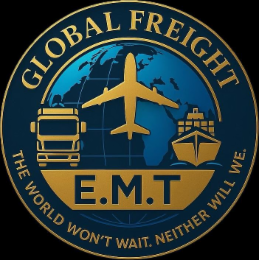| NOT AVAILABLE | At EMT Global Freight, we're not just moving freight, we're moving with purpose.Founded by U.S. Army Veteran Earnest Marshall, we operate with the same urgency, discipline, and precision that defines every successful mission. We specialize in shipping medical supplies, dairy products, hazmat, international, and general freight across the U.S., Canada, and beyond backed by real-time AI tracking and trusted carrier partnerships. We understand that in logistics, the world won't wait, and neither will we. Mission Statement "Delivery excellence isn't a promise it's our standard."Every shipment is handled with precision, urgency, and care.From coast to coast and across borders, we move with purpose, because we know what's on the line. Global InsightsStay Informed with the Latest in LogisticsIMG_5535_edited.pngCooperation between civilian and military transportation in the US The US Department of Defense (DoD) relies heavily on the civilian transportation system to support military operations, both domestically and internationally. This collaboration, often facilitated through public-public and public-private partnerships, ensures the efficient movement of troops, equipment, and supplies. Here's how civilian and military transportation work together: 1. Federal coordinationThe Department of Transportation (DOT) and DoD maintain extensive interagency relationships, utilizing programs such as the Maritime Security Program (MSP), Civil Reserve Air Fleet (CRAF), Strategic Rail Corridor Network (STRACNET), and Strategic Highway Network (STRAHNET) to secure necessary sealift, airlift, and domestic land transit capacity. 2. Infrastructure collaborationThe U.S. DOT's Maritime Administration (MARAD) has designated 23 strategic ports, including 18 commercial ones, for military deployments. STRACNET (rail) and STRAHNET (highway) are vital networks connecting over 200 military bases and strategic ports, managed in partnership by the Federal Highway Administration (FHWA) and the Military Surface Deployment and Distribution Command's Transportation Engineering Agency (SDDCTEA). 3. Commercial partnershipsThe military contracts with civilian carriers for various transportation needs, including air, sea, and land transport for both troops and equipment. Examples include using contracted local drivers and civilian airlines for transporting personnel and goods in operational theaters. Civilian assets can also be mobilized to supplement military capabilities during contingencies. 4. State and local level engagementStates cooperate with military bases to fund and improve defense transportation infrastructure, such as roads and access routes. State DOTs collaborate with the military on transportation planning, though federal coordination is generally more formalized than state and local connections. 5. Technology and efficiencyThe military aims to optimize the use of existing transportation infrastructure and incorporate new technologies for improved efficiency. Areas of collaboration between DOTs and the military in research and development include autonomous vehicles, cybersecurity, and physical security. Effective cooperation between civilian and military transportation sectors is essential for national security, supporting military operations, and responding to crises. |
